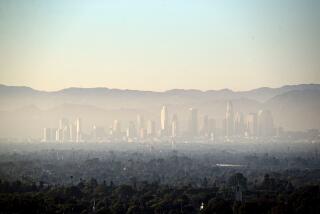EPA Puts a Chill on Snowmobiles
The Environmental Protection Agency, in a report released Monday, recommends that snowmobiles be banned from Yellowstone and Grand Teton national parks, stating that wintertime exhaust from the popular snow machines violates air quality laws and jeopardizes human health.
The EPA report says that the agency is concerned that as a result of the Bush administration’s decision to postpone a phased elimination of snowmobiles, “air quality, human health and visibility continued to be impaired” last winter.
The report is part of a public comment process that will lead to a final decision on the use of snowmobiles in Yellowstone and Grand Teton by the National Park Service next November. Comments on the Park Service’s snowmobile regulations will be accepted until May 29.
“The EPA is saying the Park Service has abundant evidence of snowmobile damage in Yellowstone and that it made the right judgment a year ago when it decided to phase out snowmobile use,” said Jon Catton, spokesman for the Greater Yellowstone Coalition in Bozeman, Mont.
Snowmobile interests argue that the EPA’s findings ignore data from manufacturers that show some new engine designs are cleaner and quieter than those made even a couple of years ago.
“I’m really surprised that the EPA didn’t look at all of that,” Jack Welch, president of BlueRibbon Coalition, told Associated Press. The Pocatello, Idaho-based group advocates keeping federal lands open to snowmobilers and other motorized recreation.
According to the EPA, the best way to control air pollution while continuing to permit some mechanized access in winter is to go ahead with a ban while allowing multi-passenger “snow coaches” that resemble small buses on motorized tracks. Those vehicles would be environmentally acceptable, the agency concluded.
“EPA fully supports continued winter access to ... national parks. EPA is satisfied that ... park resources can be protected while maintaining motorized winter access,” wrote Max H. Dodson, an assistant regional EPA administrator in Denver, in an April 23 letter to the Park Service.
The Clinton administration decision to ban the vehicles was reached in 2000 but revisited under President Bush after the International Snowmobile Manufacturers Assn. and others filed a lawsuit challenging the pending ban. Under a settlement agreement, the National Park Service proposed a variety of options to permit at least limited snowmobile use, even as Yellowstone rangers donned respirators last winter to protect themselves from noxious exhaust.
Among the options being considered by the Park Service, besides imposition of a ban, are limits on the number of snowmobiles, cleaner machines and better supervision by rangers or guides. But the EPA, in detailed comments on the proposals, disputed whether those controls could be enforced or produce significant results.
Specifically, the EPA said most of the proposals would continue to allow unacceptably high levels of carbon monoxide, a harmful gas from tailpipes.
For example, Montana’s carbon monoxide limit is 23 parts per million, but snowmobiles congregating at Yellowstone’s busy west entrance would increase pollution levels 39% over the limit, said Phillip Strobel, an environmental engineer for the EPA. Snowmobile use could also violate federal air quality standards under the right meteorological conditions, he said.
The Park Service “has been aware of this significant air quality issue for a number of years and we therefore do not understand why it is not addressed in ... all alternatives considered in” its environmental impact study, the EPA report says.
Under stagnant, cold conditions, pollution gets trapped low to the ground and can quickly build to harmful levels. Rangers at Yellowstone have resorted to wearing gas masks in the winter to protect against the fumes and fresh air is pumped into their kiosks.
Carbon monoxide cheats the body of oxygen by binding to red blood cells. In high doses, it can be fatal. In low doses it can cause dizziness, headaches, nausea and neurological impairment.
Last winter, about 70,000 snowmobiles descended on Yellowstone along with hundreds more at nearby Grand Teton National Park. The machines lack efficient engines or pollution control devices like cars or light trucks and their emissions contribute to impaired visibility. Environmentalists and Park Service studies, too, raise concerns about noise and nuisance to wildlife and other park visitors.
The lawsuit by the snowmobile makers was joined by the BlueRibbon Coalition and the state of Wyoming. Off-road enthusiasts say snowmobiles are compatible with the park and benefit the local economy. They have charged the Clinton administration’s proposed ban would unfairly limit their access to public land. Representatives for snowmobile-making companies could not be reached for comment.
More to Read
Sign up for Essential California
The most important California stories and recommendations in your inbox every morning.
You may occasionally receive promotional content from the Los Angeles Times.










